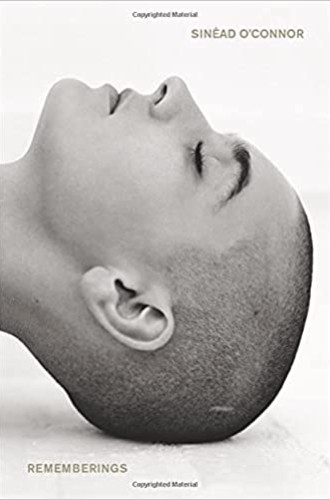Sinéad O’Connor knows exactly who she is
Rememberings is the story of a pop star, protest singer, and prophet.
I was 16 years old in October 1992, when Sinéad O’Connor appeared on the stage of Saturday Night Live wearing a white lace gown reminiscent of the type Catholic girls wear at our first communions, sang Bob Marley’s “War” a capella, and then tore up a picture of Pope John Paul II while yelling, “Fight the real enemy,” leaving the audience in stunned silence. I was horrified. I also couldn’t help but feel the same kind of admiring awe I might feel for a classmate who yells the f-word during a school mass. Still, I’d always thought of the pope as a kindly Polish grandfather. I couldn’t imagine what he’d done to provoke such a response.
Watching the clip nearly 30 years later, knowing what I know about child sexual abuse in the Catholic Church and John Paul II’s complicity in protecting abusive clergy, I feel it should have been clear enough what O’Connor was protesting by the way she substituted “child abuse” and “children” in place of the original lyrics. But her rage was not just institutional, it was also personal. The photo she tore to pieces had hung on her dead mother’s bedroom wall. “It represented lies and liars and abuse,” she writes in her memoir, Rememberings, and the abuse she was protesting was, in large part, her own.
Read our latest issue or browse back issues.
Rememberings builds toward that pivotal moment in her early career, so by the time we reach it, we know the horrors she experienced at the hands of her mentally ill mother, who often made her strip naked and then beat her with a broomstick. She also locked her in her room, left her home alone, and starved her. At age 14, O’Connor was sent to An Grianán, an Irish institution for troubled girls adjacent to the notorious Magdalene laundries for “fallen women,” where she taught herself to play guitar.
When her mother died, O’Connor took the photo from the bedroom wall and carried it with her everywhere she went, always intending to destroy it in an act of public protest. In hindsight, it’s chilling to revisit the shame and insults heaped on O’Connor after she did so, including public threats of physical violence made by no less a cultural Catholic icon than Frank Sinatra—unimaginable in the Me Too era. But in the early ’90s, a woman speaking boldly against institutional and personal violations was branded “crazy” and swept out of the spotlight secured for her by a Grammy-winning album and a number-one hit, a version of Prince’s “Nothing Compares 2 U.” When she walks backstage after the SNL performance, “all doors have closed.” Literally. People hide from her.
And that should have been the end of her career. She went from chart-topping star to show biz pariah overnight. But those of us who were captivated by her persona and her singular voice—and impressed by her obvious courage, even if unsure of its source or aim—followed her as she produced album after album, reinventing herself, changing her religion and even her name multiple times. The stain of SNL, and later, a very public mental health crisis, remains. It’s even the occasion for this book: O’Connor doesn’t want anyone else telling her story.
Rememberings is structured roughly as “before SNL” and “after SNL.” Still, she insists that the response to her protest put her back on the right track: “Everyone wants a pop star,” she writes, “but I’m a protest singer.”
In the years since then, she’s also proven to be a prophet. She rang the alarm in the Catholic Church decades before most of us would listen. She writes that she had no desire for fame, only to “keep the contract I made with God before I ever made one with the music business.” After SNL, she had the freedom to be who she is: “imperfect. Be mad, even.”
And yes, she is mentally ill. She writes without varnish or shame about her breakdowns and hospitalizations. We so often demand that victims of abuse be sane and perfect to be believed and trusted. O’Connor’s story is about being both mentally ill and a truth teller. Rememberings makes clear that whether she is called Sinéad O’Connor or Magda Davitt or Shuhada Sadaqat, the woman knows exactly who she is, and it’s not either-or; it’s both-and.
O’Connor is well aware that she isn’t always likable and that she’s prone to bad behavior. She’s also aware of the numerous ways people and systems that should have protected her—her parents, the church, the health-care system, and even, of all people, American talk show host Dr. Phil—failed or betrayed her. And yet there’s no trace of entitled brattiness in her words.
In the audio version of Rememberings, which she reads, delightfully, herself, you can hear the emotion in her voice when she speaks of those she loves, including those she has hurt and those who have hurt her. She writes movingly about each of her four children in their particularity, about her ex-husband, her parents, her siblings and stepsiblings. You can also hear the puckish, dark-humored amusement with which she recounts girlhood capers and some of her adulthood’s more unbelievable moments, including a bizarre episode at Prince’s LA home that included “ol’ Fluffy Cuffs” attempting to intimidate her by insisting that she . . . eat soup.
O’Connor warns in the introduction that she ain’t no Shakespeare. But Rememberings reveals her to be a gifted storyteller as well as a tenderhearted contrarian with a knack for poking a finger in the eyes of the powerful. No surprises there. Readers may be surprised to find she’s also a sincerely religious person—and I do mean religious. Describing her as “spiritual” doesn’t quite capture the way she has doggedly explored various religious practices and sought wisdom within different traditions.
Her writing is full of biblical allusions; the songs on her eighth album, Theology, were all based on scripture. She may be one of the most famous lapsed Catholics, but in an early chapter she writes with conviction about the miracles at Lourdes, which she experienced herself as a girl, and about being comforted by Jesus during her own abuse. She claims that she probably became a singer because she couldn’t become a Catholic priest. But she has also learned from Rastafarians and Kabbalists and anyone who’d have a conversation with her on a sidewalk or in a juice bar. Now she says she is at home in Islam; she’s worn the hijab over her iconic shaved head since 2018.
O’Connor is back in Ireland now, chain-smoking cigarettes on her porch and also training to be a health-care worker, wishing she could have done so before the pandemic hit so she could minister to the dying—when she isn’t on tour. She says she has always wanted to do something beautiful for God, and yet, she writes, “I’ve done only one holy thing in my life and that was sing. . . . I hope it’s true that God loves a singer.”








